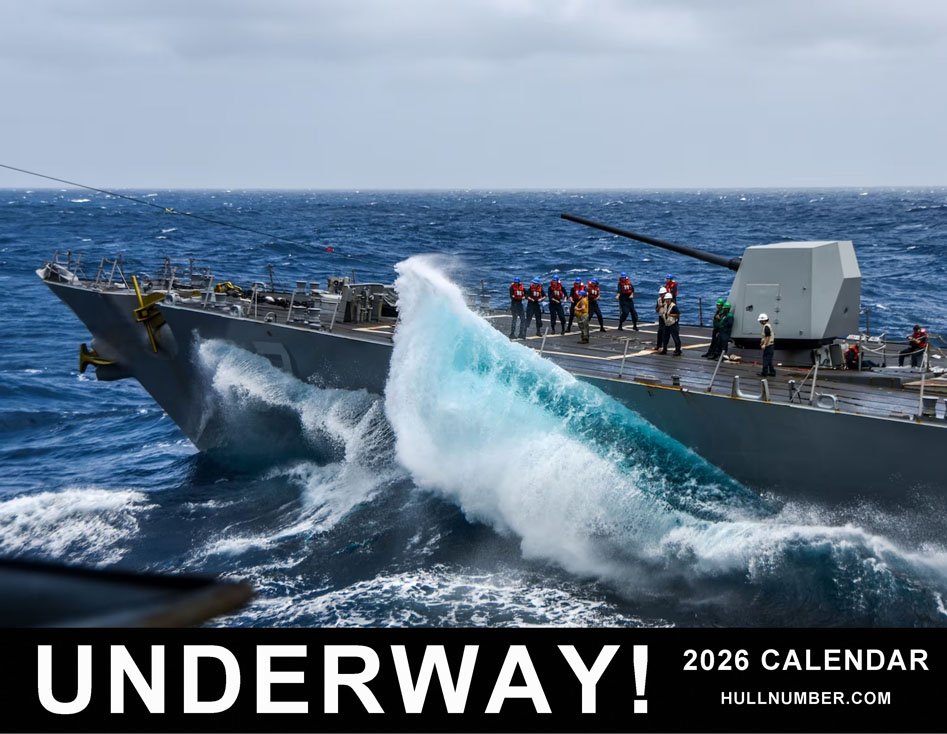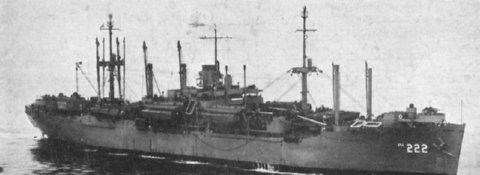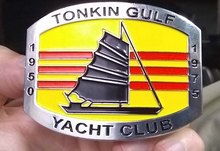 |
|||||||
| UNDERWAY! 2026 WALL CALENDAR is AVAILABLE - CLICK HERE |
|||||||
 |
|||||||
 |


U.S.S. PICKAWAY
(APA-222)SPECTEMUR AGENDO
(LET US BE JUDGED BY OUR ACTS)
Click to view crew list
USS PICKAWAY (APA-222 ) - a Haskell-class attack transport
In Commission 1944 to 1946APA-222 Deployments - Major Events
| Add a APA-222 Shellback Initiation | Add a APA-222 Deployment - Major Event | ||||
| Month | Year | to | Month | Year | Deployment / Event |
|---|---|---|---|---|---|
| SEP | 1944 | - | Keel Date: 1 SEP 1944 at Permanente Metals Corporation Richmond CA | ||
| NOV | 1944 | - | Launch Date: 5 NOV 1944 | ||
| DEC | 1944 | - | Commissioned: 12 DEC 1944 | ||
| JUL | 1946 | - | AUG | 1946 | Operation Crossroads |
| JUL | 1950 | - | JAN | 1951 | Inchon Landing |
| SEP | 1950 | - | SEP | 1950 | Inchon |
| NOV | 1952 | - | JAN | 1955 | Inchon Landing |
| SEP | 1955 | - | MAR | 1956 | West Pac-Viet Nam |
| FEB | 1956 | - | JUN | 1966 | West Pac |
| AUG | 1956 | - | Shellback Initiation - 7 AUG 1956 - Atlantic Ocean | ||
| JUL | 1957 | - | Shellback Initiation - 11 JUL 1957 - Pacific Ocean | ||
| JUN | 1960 | - | JUN | 1962 | operation seato |
| JUN | 1962 | - | Shellback Initiation - 8 JUN 1962 - Pacific Ocean | ||
| JUN | 1962 | - | JAN | 1963 | West Pac-Viet Nam |
| JAN | 1964 | - | DEC | 1964 | West Pac-Viet Nam |
| JUN | 1964 | - | DEC | 1964 | West Pac |
| JUN | 1964 | - | DEC | 1964 | West Pac-Viet Nam |
| JUL | 1964 | - | SEP | 1964 | West Pac-Viet Nam |
| AUG | 1964 | - | JAN | 1965 | West Pac-Viet Nam |
| MAY | 1965 | - | AUG | 1965 | West Pac-Viet Nam |
| MAR | 1966 | - | AUG | 1966 | West Pac |
| MAR | 1966 | - | AUG | 1966 | Circumnavigation |
| MAY | 1967 | - | DEC | 1967 | West Pac-Viet Nam |
| SEP | 1967 | - | Shellback Initiation - 7 SEP 1967 - Pacific Ocean | ||
| JUN | 1969 | - | JUL | 1969 | Alaska |
| SEP | 1976 | - | Decommissioned: 1 SEP 1976 | ||
APA-222 General Specifications
Class: Haskell-class attack transport
Complement: 536 Officers and Enlisted
Displacement: 14837 tons
Length: 455 feet
Beam: 62 feet
Draft: 24 feet
Final Disposition: Disposed of by MARAD 1 February 1980 fate unknown
USS PICKAWAY (APA-222)
Pickaway
(APA-222) was laid down by the Permanente Metals Corp.,
Richmond, Calif., as a victory cargo ship (MCV hull 570), 1 September 1944;
launched 5 November 1944; sponsored by Mrs. William D. Schoning; converted into
an APA; acquired by the Navy and commissioned 12 December 1944, Comdr. H. L.
Bixby in command.
After shakedown and amphibious exercises
at Coronado Beach, Calif., Pickaway embarked
some 1500 Army troops at Seattle, Wash., departed 9 February, arrived Pearl
Harbor 16 February, disembarked the troops and headed for Iwo Jima to evacuate
the victorious Marines who were mopping up remnant Japanese forces. Pickaway reached Iwo Jima 14 March,
received on board the 24th Marine Regiment, sailed 20 March, and returned to
Pearl Harbor 5 April.
Pickaway
participated in amphibious exercises until sailing for Guam
4 May with military passengers. Arriving Guam 17 May, she embarked soldiers,
sailors, and marines; departed Apra Harbor 22 May; and arrived San Francisco 7
June.
On 2 July she took on board Navy and
Coast Guard passengers and departed San Francisco for Noumea, New Caledonia.
Following disembarking of personnel in Noumea 8 July, Pickaway steamed to Espiritu Santo, Russell Island, and
Guadalcanal to pick up passengers and sailed 23 July for San Francisco where she arrived 6 August.
While preparing for another transpacific
voyage, the ship learned of the end of hostilities. During the remainder of
1945, Pickaway shuttled back and
forth across the Pacific embarking passengers at bases in the western Pacific
and returning them to the United States.
Remaining in the Amphibious Force,
Pacific Fleet, Pickaway visited both
Japan and China in 1947 and participated in operation Sandstorm, the second
atomic test in the Pacific, early in 1948.
On the summer of 1950, a month after the
North Korean forces marched against South Korea, Pickaway began shuttling U.S. Army troops from Japan to Pusan to
stem the tide of battle. On 15 September 1950, she saw her first real
amphibious invasion at Inchon, Korea, when the U.N. forces flanked the North
Koreans. During the Korean conflict, Pickaway
was deployed to the Korean area four times. She landed troops on most of
the major Korean beachheads.
In March 1955, Pickaway left Korea for the last time, carrying troops of the same
brigade she transported to Korea on her first trip. During 1957 and 1958, Pickaway made regular deployments to
WestPac. During Pickaway's 1958
WestPac tour, she took part in Exercise Blue Star, which was the largest
amphibious exercise conducted by Pacific Fleet forces since World War II.
After returning from the Far East in
August 1963, Pickaway entered the
Willamette Iron and Steel Co. shipyard at Richmond, Calif. for Fleet
Rehabilitation and Modernization (FRAM). In January 1964, the ship began
extensive underway and amphibious training, and in March, departed San Diego
for Hawaii, and large scale amphibious operation Westwind. On 18 June she got
underway from San Diego for a six month cruise to the western Pacific. Soon
after arriving in Yokosuka, she was ordered to proceed at once to Buckner Bay,
Okinawa, to embark a Marine Battalion for transport to Viet Nam to help build
up American forces after Communist torpedo boats had attacked U.S. destroyers
in the Gulf of Tonkin.
In March 1965, she participated in the
Pacific Fleet Exercise Silver Lance. On 24 May 1965, she again bolstered the
Allied military effort in Vietnam. On 7 July 1965 together with other elements
of Amphibious Squadron 3, Pickaway landed
the 2nd battalion of the 9th Marine Regiment over the beaches of Da Nang, South
Viet Nam.
During 1966 she participated in
operations Jackstay, Osage, Deck House I, Nathan Hale, Deck House II,
and Hastings.
After overhaul and training out of San
Diego, Pickaway departed San Diego 31
May for the western Pacific and after offloading cargo at Da Nang, proceeded to
Manila for participation in the SEATO training exercise Sea Dog. On 19
October Pickaway replenished Oriskany (CVA-34) at sea in the Tonkin
Gulf. Pickaway spent 1968 operating
out of San Diego, Calif.
Pickaway received
one battle star for World War II service and six battle stars for Korean War
service.
[Note: The above USS PICKAWAY (APA-222) history may, or may not, contain text provided by crew members of the USS PICKAWAY (APA-222), or by other non-crew members, and text from the Dictionary of American Naval Fighting Ships]
